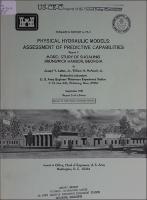Please use this identifier to cite or link to this item:
https://hdl.handle.net/11681/3263| Title: | Physical hydraulic models--assessment of predictive capabilities. Report 3, Model study of shoaling : Brunswick Harbor, Georgia |
| Authors: | Letter, Joseph V. McAnally, William H. |
| Keywords: | Closure Shoaling Sediment transport Sedimentation Deposition Data analysis Fixed-bed models Hydraulic models Brunswick Georgia Brunswick (Ga.)--Harbors |
| Publisher: | Hydraulics Laboratory (U.S.) Engineer Research and Development Center (U.S.) |
| Series/Report no.: | Research report (U.S. Army Engineer Waterways Experiment Station) ; H-75-3 rept.3. |
| Description: | Research Report Abstract: This study evaluates the sedimentation predictions of the fixed-bed model study of Brunswick Harbor, Ga. The predictions and subsequent prototype data analysis addressed the impacts of two closure dams in the vicinity of the harbor. The periods of analysis covered approximately 6.5 years prior to construction of the first closure dam, 5.5 years between the first and second closure dams, and 1 year after the completion of the second closure dam. The model study employed gilsonite (a noncohesive, finely ground asphaltic material) as a tracer, while the prototype sediment is highly cohesive clay. The model correctly predicted the reduction and redistribution of shoaling with the first closure dam. However, with the second closure dam, the model erroneously predicted a large reduction in shoaling volumes, while the prototype experienced a slight increase in shoaling. It is concluded that the prediction for the second closure dam was in error due to the difference in basic criteria for transport and deposition in the model and prototype (noncohesive versus cohesive, respectively) and to the drastic change in hydraulic conditions with the second closure dam relative to the shoaling verification and to the noncohesive critical velocity for transport of the model sediment. It is recommended that cohesive sediments should be modeled by the smallest and lightest model tracer that can be realistically used and that when tracer transport is stopped by subcritical bed shear stresses, the results should be identified as potentially erroneous. Also, physical model tracer tests should be avoided or carefully qualified when testing for the effects of drastic changes in the basic parameters governing cohesive sedimentation. NOTE: This file is large. Allow your browser several minutes to download the file. |
| Rights: | Approved for public release; distribution is unlimited. |
| URI: | http://hdl.handle.net/11681/3263 |
| Appears in Collections: | Research Report |
Files in This Item:
| File | Description | Size | Format | |
|---|---|---|---|---|
| RR-H-75-3-Report-3.pdf | 24.51 MB | Adobe PDF |  View/Open |